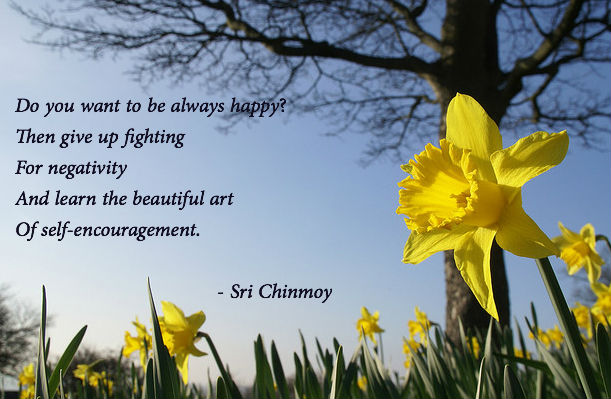The Secrets of Happiness by Jogyata Dallas
The quest for lasting happiness lies at the very heart of all human purpose and experience, though this much desired attainment is sought in many different ways. Among the ways that have proven successful a number of recurring themes are evident.
The perennial philosophies of our spiritual teachers urge self-perfecting, the inner way, while most of mankind is searching in the outer world ? right person, right possessions, right place.
Here are a few pointers that work:
Start Within
A huge wealth of highly credible literature and teachings concur that happiness is first of all an inner accomplishment, not just a series of circumstances. Prayer, contemplation, quiet time, simply sitting with peaceful music, the practice of inner stillness, all help in developing understanding, balance, an inner harmony and poise. Happiness arises out of these practices like the fragrance of a flower.
Visualise Your Day
Take five minutes at the start of each day to visualize what you intend to accomplish ? prepare the mind, your life energy, and burst into your day with vigour, intensity, calm resolve and joy. Every day we create our world with our mind ? our moods, emotions, attitudes and consciousness. Train the mind and fill it with inspiration and positive energies, self-faith, the bright colours of your heart and soul.
Be Healthy
Try to achieve excellent and enduring physical health through regular cardiovascular exercise and reasonable diet. The well-being of the body creates the foundations of a lasting happiness. Body, mind, heart, soul interconnect and impact on each other ? happiness is helped by physical well-being as well as by stress free living, simplicity, spiritual awakening. The body is the temple, the soul is the shrine, happiness the fragrance.
Compassion and Kindness
Practice kindness and acts of self-giving. When we use our good qualities to serve others, our good qualities multiply. When we neglect these and live only for ourselves, they wither. This is karma yoga, spirituality in action ? the ego is erased, the heart widens, our oneness with others expands and deepens. Happiness blossoms when we see and serve the divinity in everything around us.
Gratitude
Try not to feel burdened by life or see yourself as frail and vulnerable. See every trial and challenge as an opportunity to learn, grow, triumph, and see yourself as having much undiscovered strength and capacity. Feel gratitude for your life ? for what you have and what you do not have, who you are and who you are not. Feel your life perfection and your own blossoming perfection. You are the soul and your talents and capacities are boundless ? it?s really true.
Simplicity
Simplicity is the shedding of everything that prevents our enlightenment. Our world dazzles us with endless enchantments ? we will be happy if we have more, if we acquire this, that. But simplicity brings a happiness that comes through having less, achieving desirelessness. For desires do not diminish through fulfillment but deepen and multiply. The more we get, the more we want. Simplicity is an inner achievement ? ?simplicity is an advanced course? as Sri Chinmoy succinctly says.
“Desire is a cord that binds us to the world ? simplicity severs the cord and brings detachment and freedom. According to the spiritual masters, the ultimate simplicity is the surrender of one?s self-determination to God.”
Heart Not Mind
The mind plays a dominant role in our modern life and slowly fills up with the ambitions, ideas, hopes and expectations that eventually shape our lives. We superimpose upon the flowing stream of our life all the limiting impositions and plans of the mind, but often at the expense of our happiness. Learn to ?feel? your life?s direction rather than plan and change it; listen to the wisdom of the spiritual heart, not the cautious deliberations of the mind; and ?see? your way forward with intuition and instinct rather than create it with the mind?s limited intent. ?Living in the heart?, a gift earned through spiritual practice and simplicity, recognises our life?s deeper purpose and gives us the courage to follow this. The heart knows how to be happy.
Have a Sense of Humour
Although our strong sense of ?I? and ?me? makes each of us the epicentre of our universe, six billion other ?I?s? and ?mes? are also out there at the centre of their universe, all playing the leading role in their own private drama-comedy. A sense of humour gives us a light touch and reminds us that, like characters in a play, our role will be over very soon, the curtain will fall and we?ll go back to the changing room (the soul?s world) to prepare for another part. Like Groundhog Day, we wake up every day of our life (and every life in our many incarnations) and confront the same personal reality and unresolved issues until we at last get it right ? and what ?getting it right? really means is something you have to discover for yourself. Smiling about all this both unburdens us and gives us inner calm ? helpful benefits in the torrid battlefield of life.
Try Meditation
I?m serious. One day, probably too late, you?ll wake up and realise that your lifelong pursuit of material things and nest building isn?t really working ? you?ve had some fun, done pretty well, but you?re feeling unfulfilled and a bit empty inside. That?s because this isn?t really what it?s all about and real happiness, permanent happiness, is instead about personal enlightenment, freedom from suffering and egotism, discarding the ignorance that hides our true nature. So life will keep hitting you hard until you realise this ultimately liberating truth. Meditation will awaken this inner knowledge, reconnect you with your essential spiritual nature, show you a ?way out? of the discontent of your life. If you are ready and sincerely willing to try, your inner progress will be your life?s true accomplishment and finally the measure of it?s real worth.
Test these guidelines in your own life – see for yourself if they work. But make a start, for as the Latin proverb goes – Aut tunc, aut nunquam – it was then or never?.
More articles on Self Improvement and Happiness
Seven Steps to Inner Peace at Sri Chinmoy Inspiration
Jogyata Dallas.
Jogyata Dallas is a meditation Student of Sri Chinmoy and lives in Auckland New Zealand, where he gives free meditation classes on behalf of the Sri Chinmoy Centre
Poems on Happiness at Sri Chinmoy Poetry




